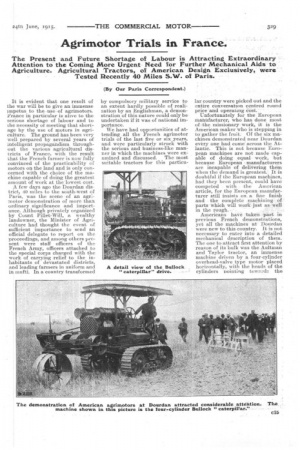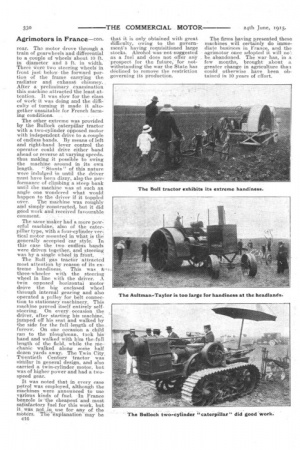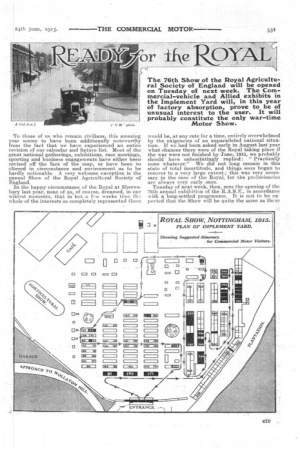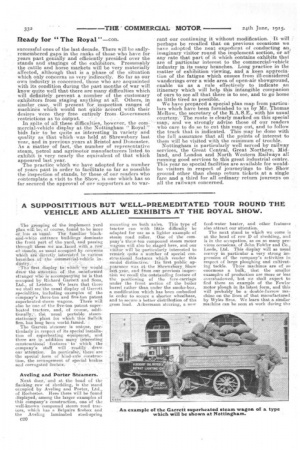Agrimotor Trials in France.
Page 3

Page 4

Page 5

Page 6

If you've noticed an error in this article please click here to report it so we can fix it.
The Present and Future Shortage of Labour is Attracting Extraordinary Attention to the Coming More Urgent Need for Further Mechanical Aids to Agriculture. Agricultural Tractors, of American Design Exclusively, were Tested Recently 40 Miles S.W. of Paris.
(By Our Paris Correspondent.)
It is evident that one result of the war will be to give an immense impetus to the -useof agrimotors. France in particular is alive to the serious shortage of labour and to the necessity of meeting that shortage by the use of motors in agriculture. The ground has been very well, prepared by several years of intelligent propagandism throughout the various agricultural districts of France, with the result that the French farmer is now fully convinced of the practicability of motors on the land and is only concerned with the choice of the machine capable of doing the greatest amount of work at the-lowest cost.
A few days ago the Dourdan district, 40 miles to the south-west of Paris, was the scene of an agrimotor demonstration of more than ordinary significance and importance. Although privately organized by Count Pullet-Will, a *wealthy landowner, the Minister of Agriculture had thought the event of sufficient importance to send an official delegate to report on the proceedings, and among others present were staff officers of the French Army, officers attached to the special corps charged with the work of carrying relief to the inhabitants of devastated districts, and leading farmers in uniform and in mufti. In a country transformed
by compulsory military service to an extent hardly possible of realization by an Englishman, a demonstration of this nature could only be undertaken if it was of national importance.
We have had opportunities of attending all the French agrimotor trials of the last five or six years, and were particularly struck with the serious and business-like manner in which the machines were examined and discussed. The most suitable tractors for this particu lar country were picked out and the entire conversation centred round price and operatin-g cost. • • Unfortunately for the European mainifacturer; who has done most of the missionary -work, it is the American _maker who is stepping in to gather the fruit. Of the six machines demonstrated near Dourdan every one had come across the Atlantic. This is not because European machines are not made capable of doing .equal • work, but because European manufacturers are incapable Of delivering them when the demand is greatest: It i5 doubtful if the European machines, had they been present, could have competed with the American article, for the European •manufacturer still insists on a fine finish and the complete machining of: parts -which will work just as well
in the rough. • • .
Americans have taken part in previous French demonstrations, yet all the machines at Dmirdan were new to this country. It is not necessary to enter into a detailed mechanical description of them. The one to attract first attention by reason of its bulk Was the Aultruan and Taylor tractor, an immense machine driven by a four-cylinder overhead-valve type motor placed horizontally, with the heads of the cylinders pointing towPals the rear. The motor drove through a train of gearwheels anddifferential to a couple of wheels about 10 ft. in diameter and 3 ft. in width. There Were two steering wheelsin front just below • the forward portion of the frame carrying the radiator and exhaust chimney. After a preliminary. examination this machine attracted-the least attention. It was slow for the class of wOrkit was doing and the, difficulty of turning it made it altogether unsuitable for French farm
ing conditions. .
The other extreme was provided b-y the Bullock caterpillar tractor with a two-cylinder opposed motor with independent drive to a couple of endless bands. By means of left and right-hand lever control the operator could drive either band ahead or reverse at varying speeds, thus making it possible to swing the machine around in its own length. " Stunts-" of this nature were indulged in until the driver must have been dizzy, also the per
formance of -climbing a -steep bank until the machine was at such an
angle one wondered what would
happen to the -driver if it toppled Ozer. The rnachine was roughly and simply bonstructed, but it did plod work and received favourable: comment.
The same Maker had a more powerful machine, also of the cater pillar type, with a fouNcylinder ver
tical motor mounted in what is the generally accepted bar style In
this case the two endleSs bands were driven together,. and steering was by a single Wheel in front. The Bull gas tractor attracted most attention by reason of its ex treme handiness. This was three-wheeler with the steering wheel in line with the driver. A twin opposed horizontal motor drove the big enclosed wheel through internal gearing and also operated a pulley for belt connec
tion to stationary -machinery. This. niachine proved itself entirely self
steering. On every occasion the driver, after starting his machine,. jumped off his seat and walked by the side for the full -length of the furrow. On one occasion a child ran to the ploughman, took his hand and walked with him the-full length of the field, while the niechimic walked along smile half dozen yards away, The Twin City, TWentieth Century tractor was sirnilar in general design, and also carried a twin-cylinder motor, but was of higher power and had a twospeed gear.
It was noted that in every case petrol was employed, although the
machines were announced to use various kinds of fuel. In France b'enzole is the cheapest and mot satisfactory "fuel for this work. but it NV-SA..4ot, in_ use for any of the match's. •The'e'xPlanation may be
016 that it is only obtained with great difficulty, owing to the government's having requisitioned large stocks. Alcohol was not suggested as. a fuel and does not offer any prospect for the future, for notwithstanding the war the State has deClined to remove the restriction governing its production. The firms having presented these machines will certainly do immediate business in France, and the agrimotor once adopted it will no _ be abandoned. The war has, in a few months, brought about a greater change in agriculture than could otherwise hav-e been obtained in 10 years of effort.
'To those of us who remain civilians, this araav.ing year seems to have been additionally noteworthy from the fact that we have experienced an entire revision of our calendar and fixture list. Most of the • great national gatherings, exhibitions, race meetings, sporting and business engagements have either been revised off the face of the map, or have been so altered in circumstance and environment as to be hardly noticeable. A very welcome exception is the annual Show of the Royal Agricultural Society of England. •
In the happy circumstance. of the Royal at Shrewsbury last year, none of us, of course, dreamed, in our wildest• moments, that in but a f.9w weeks time thc.! whole of the interests so completely represented there would be, at any rate for a time, entirely overwhelmed by the exigencies -of an unparalleled national situation. If we had been asked early in August last year what-chances there were of the Royal taking place if the war were not finished by June, 1915, we probably should have unhesitatingly replied: " Practically none whatever." We did not long remain in this state of total incertitude, and things soon began to recover to a very large extent; this was very necessary in the Case of • the Royal, for the preliminaries are always very early ones..
Tuesday of next week, then, sees the opening of the 76th annual exhibition of the R.A.S.E., in aecordance with a long-settled programme. It is not to be expected that the Show will be quite the same as these
Ready for "The Royal"—con.
successful ones of the last decade. There will be sadlyremembered gaps in the ranks of those who have for years past genially and efficiently presided over the stands and stagings of the exhibitors. Presumably the cattle and horse markets will be very materially affected, although that is a phase of the situation which only concerns us very indirectly. So far as our own industry is concerned, those who are acquainted with its condition during the past months of war will know quite well that there are many difficulties which will definitely _prevent a number of the customary exhibitors from staging anything at all. Others, in similar case, will present for inspection ranges of machines which would not quite accord with their desires were they free entirely from. Government restrictions as t.d OilIP t
In spite of all these difficulties, .however, the commercial-vebicle display at the Nottingham " Royal!' i
bids fair to be quite as interesting n variety and quality as that which was held at ShrewSbury last year, And in previous years at Bristol and Doncaster. As a Matter of fact, the number of representative steam, petrol and agrimotor manufacturers listed to exhibit is very nearly the equivalent of that which appeared last year. The practice which we have adopted for a number of years past in order to facilitate so far as possible the inspection of stands, by those of our readers who contemplate a visit to the Show, is one Which has so far secured the approval of our Supporter§ as to war rant our continuing it without modification. -It will perhaps be recalled that on previous occasions we have adopt:,.d the neat expedient of conducting an, imaginary visitor round the implement section, or at. any rate that part of it which contains exhibits that are of particular interest to the commercial-vehicle industry in its many branches. Long practice in the matter of exhibition viewing, and a keen appreciation of the fatigue which ensues from ill-considered wanderings over a wide area of open-air showground, enable us as a rule effectively to indicate an itinerary which will help this intangible companion of ours to see all that there is to see, and to go home as little tired as possible.
We have prepared a special plan map from particulars which have been furnished to us by Mr. 'Thomas McRow, the secretary ' of the R.A.S.E. with his usual i i
courtesy. The route s clearly marked on this special -map, and we strongly advise those of our readers who care to do so to cut this map out, and to follow the track that is indicated. This may be done with the full assurance that all the points of interest to them will be visited with the minimum of trouble.
Nottingham is particularly well served by railway services the Great Central, Great Northern, Mid-land, arid London and North Western Railways all running good services to this great industrial centre. This year no special facilities are available for wouldbe visitors in respect of journeyings to the Show ground other than cheap return tickets at a single fare and a third for all ordinary return journeys on all the railways concerned.




























